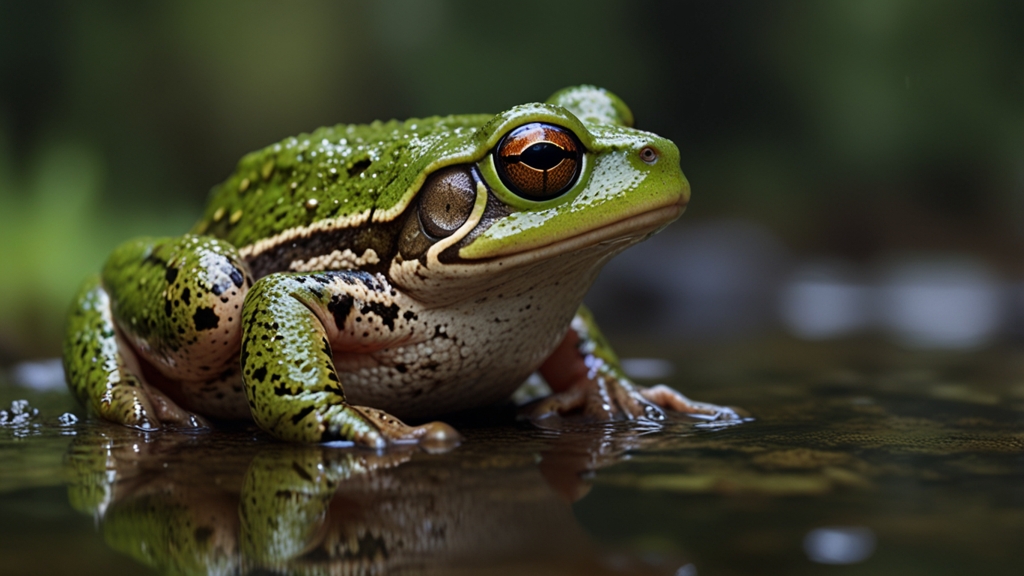Introduction to Frog Songs
Frogs and their enchanting songs have long been a subject of fascination for both nature enthusiasts and scientists alike. These amphibians, with their wide range of vocalizations, create one of the most enigmatic soundscapes in nature. Contrary to their diminutive size, the calls of frogs can be profoundly loud, diverse, and complex. From the rhythmic croaks to the melodic trills, frog songs play a crucial role in their ecology and serve as a window into the health of their habitats.
The Purpose Behind the Chorus
Frog calls are much more than random nocturnal noises. They are critical to several aspects of a frog’s life, particularly in the arenas of reproduction and territoriality. Male frogs predominantly produce these sounds to attract females or to ward off other males from their territories. Each species has a unique call, acting like a sonic fingerprint, which prevents interbreeding and helps females identify suitable mates.
“The call of a frog is its most prominent tool for survival and reproduction,” says Dr. Linda Moore, a herpetologist at the University of EcoScience. “It's a fascinating example of how evolution shapes behavior to blend functionality with the art of communication.”
The Mechanics of Frog Songs
The astonishing variety in frog vocalizations is made possible by the specialized vocal apparatus these amphibians possess. Most frog species have a vocal sac, which inflates and acts as a resonating chamber, amplifying the sounds produced. These vocal sacs can be single or paired, external or internal, depending on the species.
The sounds themselves are produced by the larynx and modulated by the mouth cavity. Variations in pitch, tempo, and volume allow frogs to produce an array of calls from deep bass croaks to high-pitched whistles, creating a diverse natural soundscape that can be both soothing and startling.
Frogs as Bioindicators
Frog calls are not only pleasing to the ear but are of significant importance to environmental monitoring. Frogs are highly sensitive to changes in their environment, making them excellent bioindicators. A thriving frog chorus generally indicates a healthy ecosystem, whereas declining frog populations or a reduction in their vocal activity can signal environmental distress.
“Monitoring frog songs gives us invaluable insight into the state of our freshwater ecosystems,” remarks Professor James Turner, an ecologist at Green Earth Institute. “These amphibians can tell us more about the health of our planet than we sometimes care to acknowledge.”
The Global Diversity of Frog Songs
Frog songs vary dramatically across the globe, reflecting the incredible diversity of frog species and their habitats. In tropical rainforests, the air is often saturated with the noise of multiple frog species calling simultaneously, creating an almost hypnotic symphony. In contrast, the calls of temperate frogs may be fewer and more spaced out, yet equally potent in their purpose and uniqueness.
The red-eyed tree frog’s clicking ‘chack’ calls, the American bullfrog’s resonant ‘jug-o-rum,’ and the deafening chorus of the spring peepers in North America are just a few examples of the remarkable variation in frog vocalizations. Each call is adapted to the specific acoustic environment in which the frog lives, enhancing its chances of mate attraction and territorial defense.
Conclusion: The Enduring Mystery
Frog songs represent one of nature’s most enigmatic soundscapes, rich with purpose and diversity. They reflect the fascinating intersection of biology, ecology, and the evolutionary pressures that shape life on Earth. As we continue to study and appreciate these vocalizations, we not only gain insight into the lives of these remarkable creatures but also foster a deeper connection to the natural world around us.
In a world increasingly dominated by human-made noises, the songs of frogs remind us of the intricate and delicate symphony that is nature. Preserving these voices is not merely about saving frogs but about maintaining the harmonious balance of our ecosystems.







